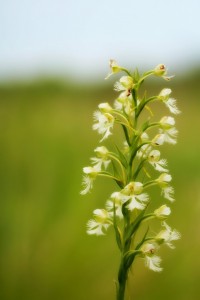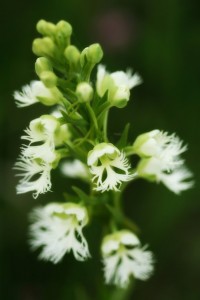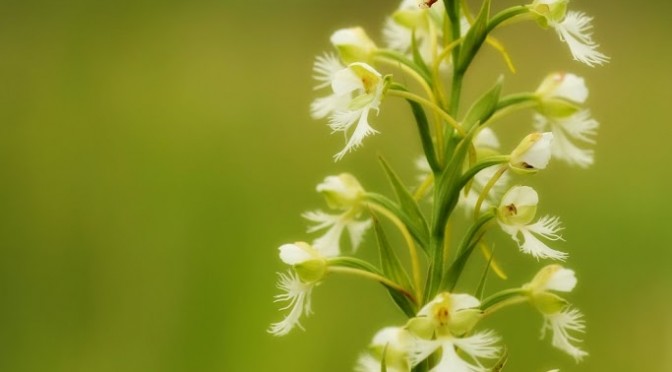 It seems to me nothing man has done or built on this land is an improvement over what was here before.
It seems to me nothing man has done or built on this land is an improvement over what was here before.
An example of one such place, land that hasn’t ever been tilled for agriculture or improved in some way for development, lies halfway between Chicago and Milwaukee. A genuine tallgrass prairie, the Chiwaukee offers a delightful mix of native grasses, uncommon sedges and drop-dead gorgeous orchids among the many wildflowers that bloom within its swells and swales.
It’s an excellent place to test your plant identification skills. I was fortunate to have a botanist and walking-encyclopedia along with me to identify plants. I’d point and Jim would spit out a Latin name. Kinda Pavlovian and fun.
I was tickled to spot this beauty first, after he walked right past it.
The Prairie White Fringed Orchid is a federally threatened speci es and like most orchids, rather mysterious in its growing habits… some years there’s lots, others not so many. We found just two, I think, on the small portion of the Chiwaukee’s 225 acres that we walked through.
es and like most orchids, rather mysterious in its growing habits… some years there’s lots, others not so many. We found just two, I think, on the small portion of the Chiwaukee’s 225 acres that we walked through.
Swaying back and forth among the grasses… delicate and exquisite… and tall at about three feet, it was easy for me to see why there are volunteers sufficiently enthralled with this particular orchid to stand in for their hawkmoth benefactors and pollinate them by hand, with toothpicks, at various sites within their range. So beautiful were they that I hardly saw any of the other wildflowers that surrounded them.
Pristine as it may be, the Chiwaukee and all its wonders are surrounded by houses and sprawl and represents just a small fragment of the native prairie that once existed in that part of the country.
It’s hard for me to imagine anyone plowing these under to grow corn or soybeans or heaven-forbid-Walmarts, but that’s not my reality. Far removed, I see only the interplay between an ancient prairie threatened by people, even as it’s watched over and appreciated by others.


It must be beautiful country. Certainly, this orchid is just fantastic.
I’ve never been able to wrap my mind around the idea that so many never seem to see the beauty and the benefit of leaving things alone. I guess it’s largely greed. So sad.
Perfectly beautiful orchid. I’m not sure I would have the appreciation to search it out but I would sure love to have it pointed out to me.
The draw of the tallgrass prairie is powerful for me too though. The vastness, the wind , and the thought of the history pulls me in.
For an insight into the history of the tall grass prairie, read “Grassland” by Richard Manning. I highly recommend this book for an understanding of what has been done to this amazing ecosystem.
There’s a place at Bryce Canyon where you can look back easward and see more than 50 miles of undisturbed land .. mostly desert. Those kinds of views, like of the praries, should be a part of everyone’s education. Or the great stands of old-growth redwoods and firs of North California/Oregon/Washington/British Columbia.
They say it wasn’t cowboys or cavalry that won the West; it was the steel plow. The prairie grass roots were too tough for conventional plow, and for a long time the prairie (because it couldn’t be made to pay its way) was considered a wasteland.
Now we have only the remnants to cherish.
“It’s hard for me to imagine anyone plowing these under to grow corn or soybeans or heaven-forbid-Walmarts, but that’s not my reality. Far removed, … “
“Far removed” being the key here. For us, procuring food means a sort drive or perhaps a short walk.
Not too long ago that was not the case.
But I’m certainly glad they didn’t plow them all.
And that our favorite blogger was able to take such wonderful images for our viewing pleasure.
Nice photos. Great commentary. Interesting you noted that the area was undisturbed by man. However, they go around pollinating flowers with toothpicks. Seems kinda dopey in my skewed view of the world. Let them be and stop messing with nature’s way. They have survived millions of years without our intervention and they will be growing over the dust of our civilizations for millions more. Thats’ probably their problem. Let the birds, bugs, bees and wind do their job. Toothpicks really ? Get a real job for cripes sake.
Happy Monday, everybody. Must have gotten up on the wrong side of the prairie today. ;P